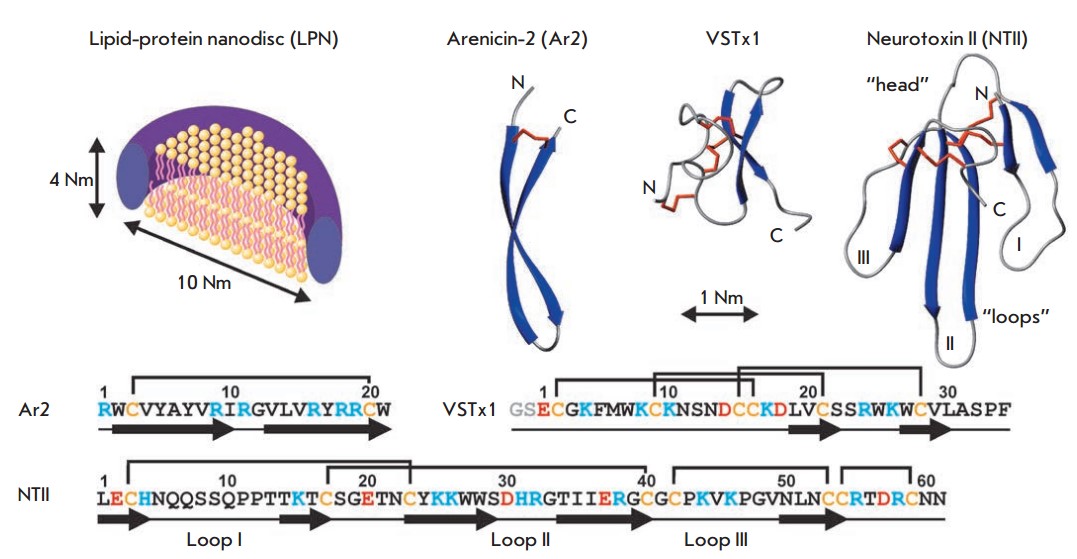Mempro™ Peptides Nanodisc Services
Creative Biostructure has developed an advanced Mempro™ Nanodisc technology platform for a long time. With our experienced scientists hammered at Nanodisc research for years, we can provide customized Mempro™ peptides Nanodisc services to meet all your demands.
Nanodisc is self-assembling discoidal nanoparticles which consists of amphiphilic α-helical scaffold proteins or peptides warped around the circumference of a lipid bilayer in a belt-like way. It’s currently accepted that Nanodisc stands for the simplest models of high density lipoprotein(HDL) particles. Membrane-active peptides (MPs) are a group of biomolecules which play a crucial role in the existence of necessary organisms and their organization. For instance, antimicrobial membrane-active peptides (AMPs), selectively working on the membranes of a variety of cells, are members of the major effectors in the “innate immunity” system, which is the pioneer defense system of eukaryotes. Several peptide mediators of the neural and endocrine systems of mammalians and a lot of animal toxins, targeted membrane receptors, display membrane activity and play at several stages as well, primarily combining the membrane encircling the receptor.

Figure 1. Schematic representation of a lipid-protein nanodisc and the amino acid sequences and spatial structures of arenicin-2, VSTx1, and NTII. (Acta Naturae 2014)
- Advantages of Mempro™ Peptides Nanodisc Services
Because of the hydrophobic properties and crucial conformational fluxility of MPs, numerous of them produce an “active” spatial structure merely in the existence of a biological membrane or a appropriate membrane mimetic. Membrane mimetic generally used have many shortcoming, which restrict their apply in the research of specific peptide–membrane interactions. The membrane fragment incorporated in a lipid-protein nanodisc shows enhanced stability and keeps various biophysical properties inherent in actual bilayer systems. Using Lipid-protein nanodiscs including multifarious lipids and their mixtures makes one to study different functional sides of membrane proteins and MPs.
- Examples of Mempro™ Peptides Nanodisc Services
The structural researches based on lipid–peptide particles have been achieved on different variants of an 18 amino acid long amphipathic a-helical peptide of apoliprotein A1 (ApoA1). This peptide was assembled synthetically to imitate the in vivo capabilities of ApoA1 and it owns nearly the alike dimensions and structure as the single alpha helices in the original ApoA1 protein. In addition, application of nanodiscs for the researches of membrane active peptides by solution NMR has been represented lately for the peptide apical membrane antigen-1 (Aam-I) from fungi. This 15N-labeled hexadecapeptide is hydrophobic and hardly soluble in water, which has been incorporated into nanodiscs with a variety of lipids by stepwise titration.
Creative Biostructure provides other various Mempro™ nanodisc preparation services. Please feel free to contact us for a detailed quote.
References:
Shenkarev Z O, Lyukmanova E N, Paramonov A S, et al. Lipid-protein nanodiscs offer new perspectives for structural and functional studies of water-soluble membrane-active peptides[J]. Acta Naturae, 2014, 6(2 (21)).
Schuler M A, Denisov I G, Sligar S G. Nanodiscs as a new tool to examine lipid–protein interactions[J]. Lipid-Protein Interactions: Methods and Protocols, 2013: 415-433.
Midtgaard S R, Pedersen M C, Kirkensgaard J J K, et al. Self-assembling peptides form nanodiscs that stabilize membrane proteins[J]. Soft matter, 2014, 10(5): 738-752.